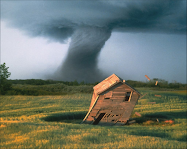A rising sequence of natural disasters may be examples of some of the less understood and more unpleasant consequences of global warming.
Geologists say that Earthquakes, volcanic eruptions, tsunamis and landslides are some of the additional catastrophes that climate change and its rising sea levels and melting glaciers could bring
The impact of human-induced global warming on Earth's ice and oceans is already noticeable: Greenland's glaciers are melting at an increasing rate, and sea level rose by a little more than half a foot (0.17 meters) globally in the 20th century, according to the Intergovernmental Panel on Climate Change.
With these trends in ice cover and sea level only expected to continue and likely worsen if atmospheric carbon dioxide levels continue to rise, they could alter the stresses and forces fighting for balance in the ground under our feet—changes that are well-documented in studies of past climate change, but which are just beginning to be studied as possible consequences of the current state of global warming.
To put this into laymen’s terms, pretend you have a round child’s balloon in your hands. Now put your hands on the top and bottom of the balloon and gently press. This is like the pressure from the weight of the water, frozen into ice, at the polar caps is exerting on the ground beneath it.
Now slowly reduce that pressure, notice the slight changes to the shape of the balloon. This is like the weight of the ice being reduced, as the water melts and drains into the oceans and the ground beneath slowly rebound from the pressure.
Now place your hands in the middle section on the balloon and gently press and you will get an idea of the weight all that additional water now exerting forces on the bottoms of the oceans and notice the changing shape. This is a simple example of how the redistribution of massive amounts of water and weight trigger seismic events.
Many people that study climate change believe that we have already passed the point of no return. That it may be too late to change our ways and save civilization as we know it.
As I was watching the talk shows last Sunday morning, I happened to catch Thomas L. Friedman, an internationally renowned author, reporter, and columnist for the New York Times—the recipient of three Pulitzer Prizes and the author of five bestselling books including his environmental bestseller “Hot, Flat and crowded”
I don’t remember which talking head was doing the interview, but he ask Mr. Friedman straight out. Do you think it is already too late? I do not have a transcript of the answer, but the jest of it was; If you woke me up at two in the morning and ask that question and I just gave you my gut answer I would probably say,” yes it already too late”
But if you ask, as I was having breakfast with me daughter, I would said that with all the ingenuity that humankind has demonstrated in the past and we can just focus the full force of our resources on the crisis, we may still advert catastrophe.”
Many scientists now believe that our best hope of survival is a focusing event. A disaster so big that it will make everyone focus on the danger and understand that if we do not change our course very soon, all will be lost. As sad as it sounds, we need an event so destructive, so off the charts, so in your face, that the profiteers and politicians will decide that the profits, no matter how great are just not worth the risk of total extinction.
Some notable examples of resent seismic activity;
Haiti - A 7.0 earthquake shook Haiti, killing an estimated 230,000 on January 12th. It injures an additional 300,000 and left over a million homeless. By the end of January at least 52 aftershocks of 4.5 are larger had been recorded. The area recorded at least 3 of that magnitude on the day of this posting.
Chile - Over 1.5 million persons were displaced on February 27 when an 8.8 earthquake struck Maule, Chile. The monster quake was the 8th largest ever recorded. A 4.9 and 5.1 were reported the date of this posting.
Recent noteworthy quakes;
Recent noteworthy quakes;
Volcano or Brain Cloud?
Eyjafjallajokull, Iceland- For the second time in less than a month a volcano located under the retreating glacier erupts after more than two hundred years dormancy. The second explosion is located more than a mile from the May 10 blast is causing widespread flooding, evacuations and disrupted air travel worldwide.
Iceland's Meteorological Office said a plume of steam rose at least five miles (eight kilometers) into the air. Scientists aboard a Coast Guard plane that flew over the volcano said the new fissure appeared to be up to 1.2 miles (2 kilometers) long. A bigger worry is Katla, which in the past has erupted in tandem with Eyjafjallajokull. Katla is located under the vast Myrdalsjokull ice cap.
What will it take to make the world wake up? Let me know what you think.C.S Goldsmith is author of “UNINHABITABLE a case for caution,” available at Barnes & Noble. Goldsmith has spent over 10 years studying the Climate Change issue from the risk assessment perspective of the Insurance industry.
To schedule an interview with Craig Scott Goldsmith, please contact Robert Schechter at 212-499-6809.








No comments:
Post a Comment